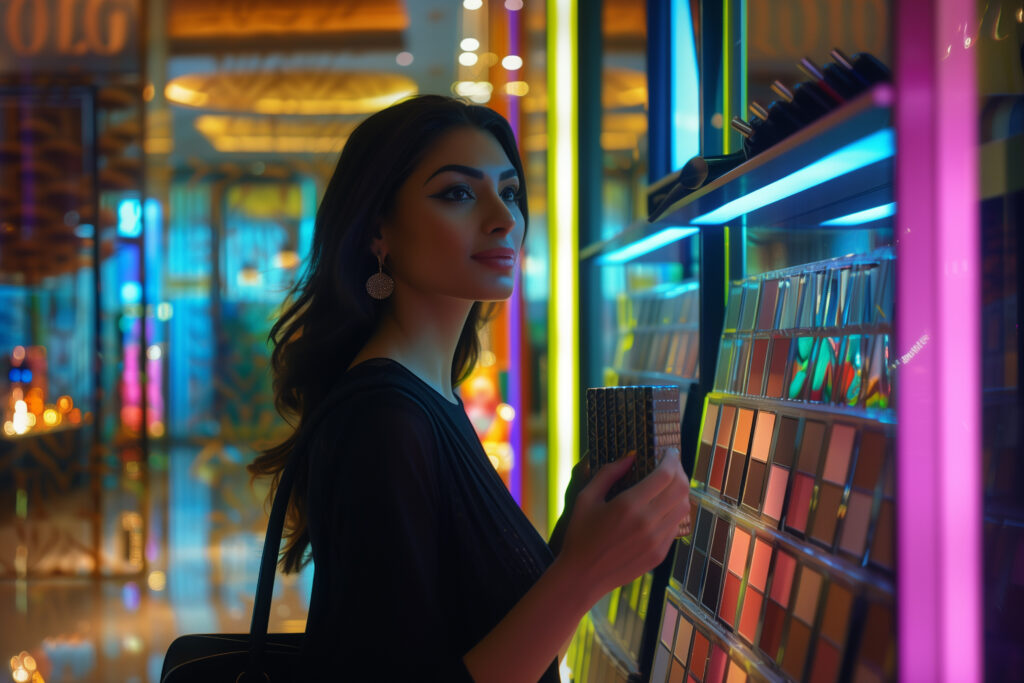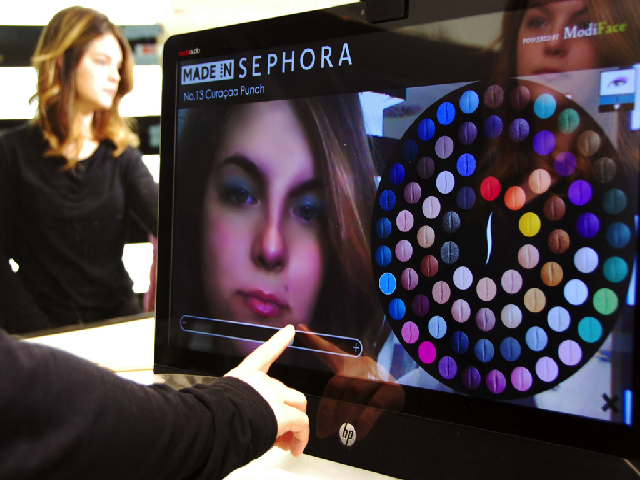In a world shaped by iPhones, Google, and social revolutions, a new generation emerged with bold opinions and a sharper sense of identity. Gen Z (born 1997–2012) didn’t just grow up with the internet—they shaped it. And now, they’re reshaping beauty retail.
This generation has redefined what luxury means. Unlike previous generations who equated prestige with price tags, Gen Z pursues beauty that aligns with their values, identity, and desire for expression — all without sacrificing affordability.
The result? A new retail category: affordable luxury beauty. Think premium-feel products, accessible pricing, and authentic storytelling. Brands like MAC (mini lipsticks), Fenty (inclusive blushes), and Kay Beauty (celebrity-backed elegance) embody this balance of aspiration and accessibility.(Ref)
Who is Gen Z? Why Gen Z Beauty Trends Matter in Beauty Retail
Representing an age group of 13 to 28 years (as on 2025), Gen Z is one of the most powerful consumer groups today, with a global spending power estimated at over $450 billion, further expected to touch $12 trillion by 2030. In the beauty retail industry, they hold even greater influence because they are not only consumers but also creators of culture and trends.
Gen Z makeup trends have already led to the debut of many affordable luxury beauty brands that thrive by meeting the expectations of this generation. Three defining traits that set Gen Zs apart are,
- Digital-first mindset: Gen Z is glued to Instagram, TikTok, and YouTube reviews. They discover new products through swatches, tutorials, and influencer reels rather than in-store counters.
- Preference for authenticity: They gravitate towards brands that champion inclusivity, transparency, and representation rather than polished perfection.
- Sustainability awareness: Unlike older generations, Gen Z is quick to call out greenwashing and demand eco-conscious alternatives.
For beauty retailers, this generation matters because they dictate what’s ‘cool’ and amplify it instantly across platforms, with the capability to turn a product viral overnight.(Ref )
Gen Z Shopping Behaviour And The Rise of Affordable Luxury in Beauty
Gen Z Trivia – Forming 30% of the population and 25% of the total global workforce, Gen Z represents a whopping 40% of consumers worldwide.
Affordable luxury in beauty refers to products that feel premium but are priced within reach of mid-level budgets. Catering strictly to Gen Z shopping behaviour, these brands and product lines deliver aspirational experiences; sleek packaging, celebrity-backed credibility and premium ingredients, without the high-ticket barrier.

Source : Gen Z shopping behaviour
Here are a few examples of affordable luxury beauty brands that Gen Zs often swear by;
- MAC Mini Lipsticks – pocket-sized indulgence at a fraction of the full price.
- Huda Beauty’s small palettes – luxury branding in compact, accessible formats.
- Sephora Collection – positioned under a premium retailer but priced for everyday use.
- Kay Beauty by Katrina Kaif – a homegrown Indian example of luxury at mid-market pricing.
- Fenty Beauty – Rihanna’s brand that balances prestige with inclusivity and approachable pricing.
Gen Z gravitates toward affordable luxury skincare and makeup trends because it delivers the best of both worlds: a touch of luxury with the satisfaction of affordability.
Key Factors Driving Gen Z Beauty Trends
Gen Z beauty trends are fueled by these 5 core factors –
- Inclusivity & Representation
This generation demands products that cater to every skin tone, gender and identity. Such is the power of Gen Z makeup trends that foundations, which once stopped at five shades, now launch with 40+. Brands like Fenty Beauty normalized this standard, and Gen Z expects nothing less.
- Ingredient Transparency
Gen Z studies labels. They look for clean, cruelty-free, and vegan products. A lipstick that boasts a “vegan, paraben-free formula” automatically scores higher than one that hides behind jargon. - Sustainability
Roughly 68% Gen Zs are eco-friendly shoppers and are ready to pay 50% or double the price for sustainable products. Eco-conscious packaging, refillable products and recyclable containers are no longer add-ons but expectations. Retailers adopting refill stations or carbon-neutral shipping methods earn the loyalty of Gen Z. - Value for Money
Prestige is important, but price matters. They seek ‘affordable prestige’; products that deliver the luxury experience without breaking the bank. In fact, 55.1% Gen Zs use BNPL, bringing luxury and price approachability to the same plate. Hence, the rise of affordable luxury skincare and cosmetics. - Digital Discovery
Social media inspires purchase decisions for more than 47% Gen Zs. From AR try-ons, as seen in apps like Nykaa and Sephora, to viral TikTok tutorials, Gen Z shops digitally first. Reviews, influencer honesty and unfiltered swatches carry more weight than celebrity endorsements.

Source : Sephora / ModiFace
Role of Social Media in Shaping Affordable Luxury Beauty Brands
Social media is the epicentre of beauty discovery for Gen Z. Viral products like Rare Beauty’s blush or Maybelline’s Sky-High mascara have become global bestsellers largely due to TikTok virality.
Dupe culture is yet another Gen Z beauty trend that allows Gen Z to find budget-friendly alternatives to high-end products, compelling luxury brands to adapt. As a result, many have launched travel-sized versions or mid-range collections of best sellers to stay relevant.
Influencers and micro-creators also play a pivotal role. Live shopping events, Instagram ‘get ready with me’ reels, and YouTube reviews guide purchase decisions in ways traditional ads no longer can.
Affordable Luxury vs. Traditional Luxury: What’s Changing?
Traditional luxury beauty was defined by exclusivity, featuring velvet counters, glass bottles, and in-store experiences. It relied on aspiration through distance.
Gen Z shopping behaviour, however, has flipped this model, where luxury must now be accessible, digital-first and community-driven. Instead of hushed department-store aisles, they want interactive AR mirrors, influencer collaborations and Instagrammable packaging and purchase interactions.
Brand collaborations further blur the lines; think H&M with designers, Nykaa with Bollywood celebrities and Sephora with leading influencers. These collaborations bring luxury into everyday shopping baskets while retaining aspirational value.
Affordable Luxury Beauty Brands – Case Studies And Examples
- Nykaa Luxe & Kay Beauty (India)
Nykaa’s Luxe platform and Katrina Kaif’s Kay Beauty have cracked the Indian affordable luxury market. By offering products with premium positioning but mid-range pricing, they’ve attracted Gen Z shoppers who want both quality and glamour. - Fenty Beauty (Global)
Fenty’s success comes from its wide shade range, inclusive marketing and approachable pricing. It set the benchmark for inclusivity and made mid-priced beauty aspirational worldwide. - Sephora Collection (Global)
Though housed among top luxury competitors, Sephora Collection stands out for its quality and affordable price points. It’s a strategic move to ensure Gen Z can participate in the Sephora experience without financial strain. - Tira by Reliance (India)
Reliance’s beauty platform, Tira, is curating a mix of mid-range and luxury products, aiming to serve Gen Z with variety, convenience, and aspirational branding in one place.
What Affordable Luxury Means for Retailers & Brands
The rise of affordable luxury skincare and cosmetics signals a clear message: accessibility is the new aspiration.
For retailers and brands, the implications are clear –
- Curated assortments: Multi-brand platforms like Nykaa, Sephora, Tira, etc. must expand affordable luxury lines to capture Gen Z wallets.
- Community-led branding: D2C brands thrive when they build authentic communities, host collaborations, and spotlight real customer stories.
- Hybrid experiences: Combine online discovery with offline touchpoints like AR try-ons with store testers, etc.
- Focus on values: Transparency, inclusivity, and eco-consciousness aren’t optional; they’re essentials to strike a chord with Gen Z beauty trends.
Brands that adapt to a ‘value-driven luxury’ mindset will stay relevant. Those clinging to conventional practices of exclusivity can risk losing Gen Z’s attention.
Gen Z Beauty Trends – What Lies Ahead
“Self-expression is not a choice; it’s a necessity” – Elijah Carter
Gen Z is reshaping beauty retail in profound ways. They’ve made it clear that luxury no longer has to mean unattainable prices or elitist branding. Instead, they seek a harmony between exclusivity, affordability, inclusivity and digital accessibility.
As this generation matures, its influence will only grow stronger. The future belongs to brands that recognize status is no longer about price tags alone but about accessibility, values and authentic experiences that fuel self-expression and individuality.

